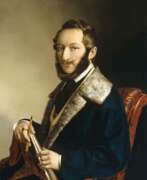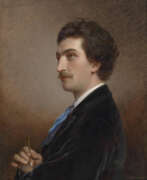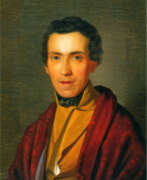Biedermeier 19th century




Jósef Borsos is a Hungarian portrait painter and photographer.
Borsos studied art at the Academy of Fine Arts in Vienna. He painted portraits of historical figures, but became best known for his genre paintings in the Biedermeier style.
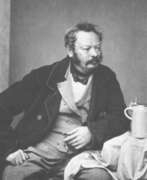

Heinrich Bürkel was a German artist of the mid-nineteenth century. He is known as a painter and graphic artist, representative of the Biedermeier style.
Heinrich Bürkel specialized in genre and landscape paintings, especially winter landscapes. He often used Staffage and depicted animals. His work showed the influence of the old Dutch and Italian masters. Bürkel enjoyed great popularity, his paintings were actively acquired for private collections, including in America. The master painted about 1000 paintings and created about 6000 drawings.


Paul Walter Ehrhardt was a German painter of the Munich School. Paul W. Ehrhardt studied with Max Thedy at the Grand Ducal Saxon Art School in Weimar and with Paul Hoecker at the Academy of Fine Arts in Munich. From 1906 he exhibited regularly in the Munich Glass Palace and at the Great Berlin Art Exhibition. Ehrhardt painted atmospheric Biedermeier interiors in muted tones. During the Nazi regime he was one of the most sought-after artists. Except for 1938, from 1937 to 1944 he was represented with 19 paintings at seven Great German Art Exhibitions in Munich, of which Hitler acquired three and the Nazi leader Joachim von Ribbentrop one. His works were represented at auctions until 2006.


Johann Philipp Eduard Gaertner was a German painter of the second quarter of the 19th century, the Biedermeier era. He is known as a landscape painter, famous for his views of Berlin and other cities.
Eduard Gaertner created many architectural landscapes of Berlin, as well as St. Petersburg and Moscow during his travels to Russia. The value of these works is that they documented the appearance of the cities on the eve of the age of photography. Gaertner's painting style underwent a change after the death of King Friedrich Wilhelm III, his patron. In keeping with the cultural attitudes of Prussia's new ruler, the artist began to paint more romantic and idealized landscapes in which architecture played a decorative role.


Johann Peter Hasenclever was a German painter of the first half of the 19th century. He is known as a painter, a representative of the Düsseldorf school of art, who is considered one of the founders of German genre painting.
Hasenclever began his work by interpreting biblical, mythological and romantic subjects, but eventually found his calling in humorous scenes from bourgeois life, especially Pyrenean towns and cities. Among his famous works are "The Amusing Examination," "The Reading Room," and "The Trial of Wine," distributed in engravings and lithographs.


Woldemar Hau (Russian: Владимир Иванович Гау) was a Baltic German portrait painter, renowned for his contributions to the Biedermeier style, a period marked by a sense of realism and simplicity in art. Born in 1816 in Tallinn, then part of the Russian Empire, he was trained under the guidance of his father, Johannes Hau, and the distinguished artist Karl von Kügelgen. Hau's remarkable talent became evident early on when, at just sixteen, he was recommended to paint for the Russian Imperial Court, leading to his appointment as a Court Painter.
During his illustrious career, Hau captured the visages of the Russian nobility, including Tsar Nicholas I and Tsarina Alexandra Fyodorovna, alongside other key figures of his time. His works, often characterized by their intricate detail and vibrant realism, include over 200 miniature portraits of the Izmaylovsky Regiment veterans. His most celebrated works are preserved in prestigious collections and reflect his mastery in both watercolours and miniatures on ivory.
For those interested in exploring the legacy of Woldemar Hau, his paintings are a fascinating window into the cultural and historical nuances of 19th-century aristocratic Russia. To stay updated on exhibitions and auctions featuring Hau's work, I encourage you to sign up for updates. This subscription will keep you informed about new sales and auction events specifically related to Woldemar Hau.


Joseph Anton Koch was an Austrian painter, draughtsman and printmaker, master of etching and illustration, novelist and representative of the classicist landscape in German art. In his native country he was associated with the Biedermeier aesthetic, and in Rome with the Nazarene society.


Johann Peter Krafft was a German and Austrian painter of the mid-nineteenth century. He is known as a painter and graphic artist who specialized in genre, battle, portraiture and history painting. Krafft is believed to have had a significant influence on Austrian painting and was a leading portraitist of the Neoclassical style in Vienna. He later influenced the development of genre painting during the Viennese Biedermeier period.
Krafft co-founded the Vienna Artists' Union and was elected to the council of the Vienna Academy of Art in 1835. The artist also acted as a consultant for the protection of cultural monuments at Karlstein Castle in Bohemia.


Gustav Kraus, also known as Gustav Friedrich or Gustav Wilhelm, was a Bavarian painter and lithographer.
He studied at the Munich Academy of Fine Arts and was admitted as a member of the Munich Art Society, and is considered a representative of the Biedermeier. In 1836 he founded his own lithographic publishing house. In his landscape works, Kraus combined topographical precision with artistic quality.
His urban and architectural vedute, depictions of historical events, including maneuvers, parades, processions, inauguration ceremonies, portraits of noble contemporaries, sketches of costumes and uniforms were published by many publishing houses. One of the most valuable of Kraus's works today is the depiction of the Oktoberfest procession of 1835 with 24 colorful lithographs.


Johann Dietrich Carl Kreul was a German genre and portrait painter and inventor of the paint rubbing machine for artists' oil paints. In 1838, he founded the first German artists' paint factory, C. Kreul, which today operates under the name C. Kreul Gmbh & Co. KG and operates under the KREUL brand.


Josef Lauer was an Austrian painter who worked during the Biedermeier period.
Josef Lauer studied painting at the Vienna Academy of Fine Arts under Sebastian Wegmayr, Josef Messmer, Thomas Ender and Franz Steinfeld. Throughout his career he devoted himself exclusively to painting flowers and fruit, becoming the first to incorporate floral still lifes into the landscape; often a forest background.


Friedrich Loos was an Austrian Biedermeier style painter, etcher and lithographer.
He studied at the Vienna Academy with Joseph Mössmer and also went on study tours through the Austrian Alpine regions. From 1835 to 1836 he lived in Vienna, and as of 1846 he sojourned in Rome. He then moved to Kiel, where he worked as a drawing teacher at the university as of 1863.


Peter Mayr was a German artist, born in 1758 in Freiburg/Breisgau and active until his death in 1836 in Munich. He was renowned for his miniature paintings, a craft in which he demonstrated exceptional skill and artistry. Peter Mayr's works were primarily executed in gouache and watercolor, showcasing his ability to capture intricate details and convey the essence of his subjects on a miniature scale.
His works, such as "Dancing peasants before a tavern" and classical representations like "Venus and Cupid" and "Reclining Venus," reveal his versatility and the influence of other artists, like David Teniers, in his creations. These artworks not only highlight his proficiency in miniature painting but also his engagement with various themes and subjects, ranging from everyday scenes to classical motifs.
Peter Mayr's art has been valued and auctioned at various reputable platforms, emphasizing his significance in the art world. His miniatures, often set in elaborate frames and executed with precision, are collected and admired for their historical and artistic value.
Collectors and art enthusiasts continue to celebrate Peter Mayr's contributions to miniature painting, and his works remain a testament to his skill and dedication to this intricate art form. For updates on new discoveries or auction events related to Peter Mayr's works, sign up for our newsletter to stay informed.




Michael Neher was a German painter and architectural decorator.
Michael studied at the Academy in Munich, in 1819 went to Italy and spent five years there, including two years in Rome, where he studied architectural painting in the studio of the artist Heinrich Maria von Hess, and in 1825 returned to Munich.
As a typical representative of the Biedermeier era, Neher produced many costume drawings and landscapes. He also became famous for his views of public places and architectural depictions of many Bavarian towns. From 1837, Michel Neher devoted himself entirely to architectural painting and traveled to improve his skills along the Rhine and to Belgium. In 1839 he painted several salons in Hohenschwangen Castle from designs by Schwind, Gasner and Schwanthaler. In 1876 he was made an honorary member of the Munich Academy.


Georg Emanuel Opiz was a German painter of the first half of the 19th century. He is known as a painter, graphic artist, printmaker and author of historical novels, publishing under the pseudonym Bohemius.
Opiz began his career with portraits, but from 1807 moved on to genre subjects. He became famous for his watercolors and gouaches depicting daily life in Paris during the Napoleonic I era. His series of lithographs "Cossacks in Paris", executed from life in 1814, became very famous. In 1819 he published a series of 24 color prints "Scenes of Characters from Life in Paris". In the 1820s, Opiz created a series of watercolors, presumably inspired by trips to Russia and the Ottoman Empire.


Lorenzo Quaglio was an Italian-born German painter of the first half of the 19th century. He is known as a painter, landscape painter, genre painter and lithographer of the German Biedermeier period, a member of the Quaglio dynasty of artists, brother of the famous architect-artist Domenico Quaglio.
Lorenzo Quaglio worked early in his career as a decorator for the court of the Bavarian Electorate and the national theater in Munich. He traveled frequently in the Bavarian and Tyrolean Alps, which inspired him to create. His works predominantly depicted scenes from the peasantry of Upper Bavaria. He also executed on stone copies of paintings from the Dresden Gallery. In 1812, he created his first lithograph with nature scenes, and from 1820 he studied Bavarian folk costume. Later he worked on the decoration of the Swan Knight Hall in Hohenschwangau Castle.


Adrian Ludwig Richter was a German Romanticist and Biedermeier painter.
Ludwig Richter studied painting at the Dresden Academy of Art. His travels, especially to Italy, played an important role in the further development of his talent, during which Richter was introduced to the Nazarenes and Joseph Anton Koch. After his return to Germany, the artist works as a draftsman at the Meissen Porcelain Manufactory, then teaches landscape painting at the Dresden Academy.
Since the late 1830s Richter is increasingly active as an illustrator (including for publications of fairy tales by the Brothers Grimm). Having made about 3,000 woodcuts for 150 works of art, Richter became one of the most popular artists in Germany. At the same time, 'large format painting' seems to recede into the background for him. A developed eye disease, which made the artist almost blind, forced him to leave painting in 1873.


Franz Ringer is a German painter, graphic designer and sculptor.
Franz Ringer came from an old Munich family of carpenters. At the age of 20 he traveled to Tyrol and Switzerland, enrolled at the Technical University of Aachen, returned to Munich and worked as an assistant to the sculptor Josef von Kramer (1841-1908) for ten years, which shaped him as a master stylistically and technically.
Ringer was one of the best-known decorative arts artists in Munich at the time, and he artistically designed many restaurants in Bavaria and in Munich. His design projects are extremely varied.
Franz Ringer is also known as the creator of stone and glass beer mugs, which he painted in Art Nouveau, Art Deco or Biedermeier style. The first Ringer mugs to go into production were made by Villeroy & Boch in 1905. These mugs quickly became popular with the public, especially at scheduled conferences and festivals. Ringer worked for many ceramic manufacturers in Germany. In addition to Villeroy & Boch, these included Reinhold Merkelbach, Merkelbach & Wick, Marzi & Remi, Albert Jakob Thewalt and others.


Johann Schlesinger was a German Biedermeier painter who painted portraits and still lifes.
He was taught the art of painting by his older brother, the painter Johann Adam Schlesinger, and his nephew Johann Jakob Schlesinger (1792-1855) was also a famous painter of the Palatinate.


Julius Schoppe was a German painter of the mid-nineteenth century. He is known as a painter and graphic artist, famous for his portraits during the Biedermeier era.
Julius Schoppe studied Italian art in Rome and copied works by Raphael, Titian and Correggio. His copies of Raphael's paintings were included in the collection of the King of Prussia and were exhibited in Sans Souci. The master was also the author of landscapes, historical and genre paintings, as well as an original series of "living paintings" that were admired for their grace and painterly authenticity. He was a professor at the Berlin Academy of Fine Arts.


Karl Schröder-Tapiau was a German painter.
He studied at the Prussian Academy of Arts, then at the Karlsruhe Academy of Arts, then settled in Dachau and after World War I he co-founded the Dachau Artists' Group (later the Dachau Artists' Association).
Karl Schröder-Tapiau painted mainly portraits and landscapes, as well as works in the Biedermeier style with touches of Impressionism. He is considered an outstanding regional painter for his landscapes with views of Dachau.


Moritz Ludwig von Schwind was an Austrian painter, born in Vienna. Schwind's genius was lyrical — he drew inspiration from chivalry, folklore, and the songs of the people. Schwind died in Pöcking in Bavaria, and was buried in the Alter Südfriedhof in Munich.


Friedrich von Amerling, an esteemed Austro-Hungarian portrait painter, is renowned for his significant contributions to the art world, particularly in the court of Franz Josef. Born in Vienna in 1803, he became one of the 19th century's most celebrated Austrian portrait artists, alongside figures like Ferdinand Georg Waldmüller. Amerling's educational journey in art took him from Vienna to Prague and further abroad to cities like London, Paris, and Rome, enriching his style and approach to portraiture.
Friedrich von Amerling's works, known for their clarity of outline and rich coloration, often draw comparisons to the style of Ingres. His most productive years spanned from 1830 to 1850, during which he became the preferred portraitist for the aristocracy and the burgeoning middle class of the Biedermeier period. With over 1000 works, predominantly portraits, Amerling's influence and legacy are profound, with the majority of his art remaining in Austria.
His life was not just limited to art; Friedrich von Amerling also led a fascinating personal life, marked by extensive travel and four marriages. His contributions to art were recognized by various honors, including elevation to nobility and the receipt of the Orden der Eisernen Krone. Today, Amerling's work continues to be celebrated, with his portraits offering a window into the aristocratic and middle-class society of his time.
For collectors and experts in art and antiques, Amerling's work represents an invaluable link to Austrian cultural history and portrait artistry. To stay updated on sales and auction events related to Friedrich von Amerling's works, signing up for relevant updates is recommended, providing exclusive insights into acquiring pieces of this remarkable artist's legacy.
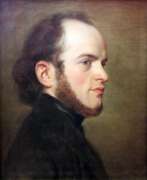

Adolph Friedrich Erdmann von Menzel was a German Realist artist noted for drawings, etchings, and paintings. Along with Caspar David Friedrich, he is considered one of the two most prominent German painters of the 19th century, and was the most successful artist of his era in Germany. First known as Adolph Menzel, he was knighted in 1898 and changed his name to Adolph von Menzel.
His popularity in his native country, owing especially to his history paintings, was such that few of his major paintings left Germany, as many were quickly acquired by museums in Berlin. Menzel's graphic work (and especially his drawings) were more widely disseminated; these, along with informal paintings not initially intended for display, have largely accounted for his posthumous reputation.


Sebastian Wegmayr was an Austrian painter of the Biedermeier period.
He studied at the Vienna Academy of Fine Arts, then taught floral painting there. Wegmayr specialized in still lifes, both lush floral, fruit and game.


Anton Zwengauer was a German painter of the mid-19th century. He is known as a landscape painter and is considered a representative of the Biedermeier artistic movement.
Zwengauer traveled extensively in the Alps early in his career, creating sketches and watercolors. His painting "Sunset at Dachauer Moos" brought him recognition, and "sunsets" became his characteristic subject, known as "Zwengauers". The artist sought to convey the inner strength and peace of nature, often depicting sunsets and creating impressive lighting effects through simple means.


